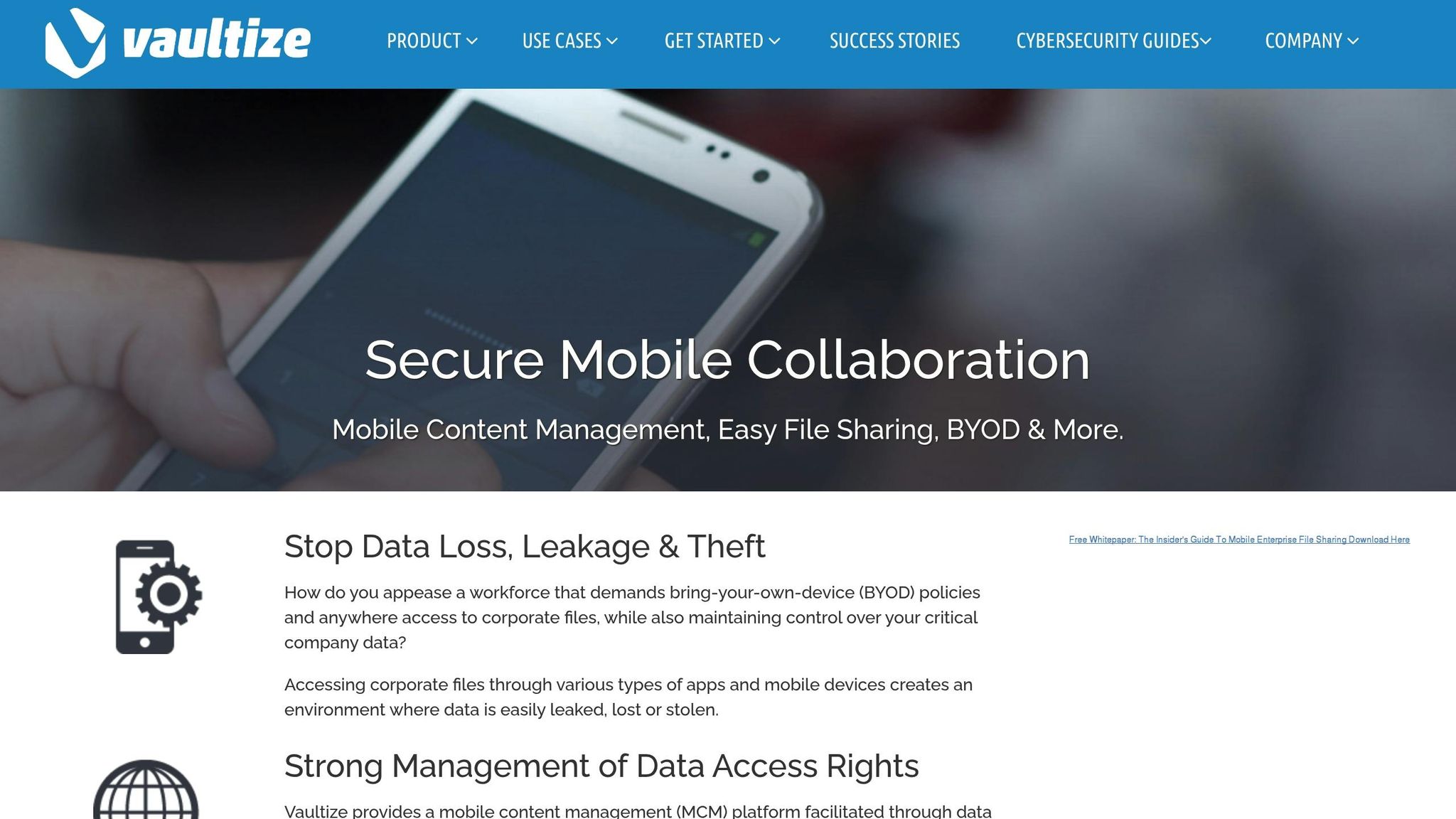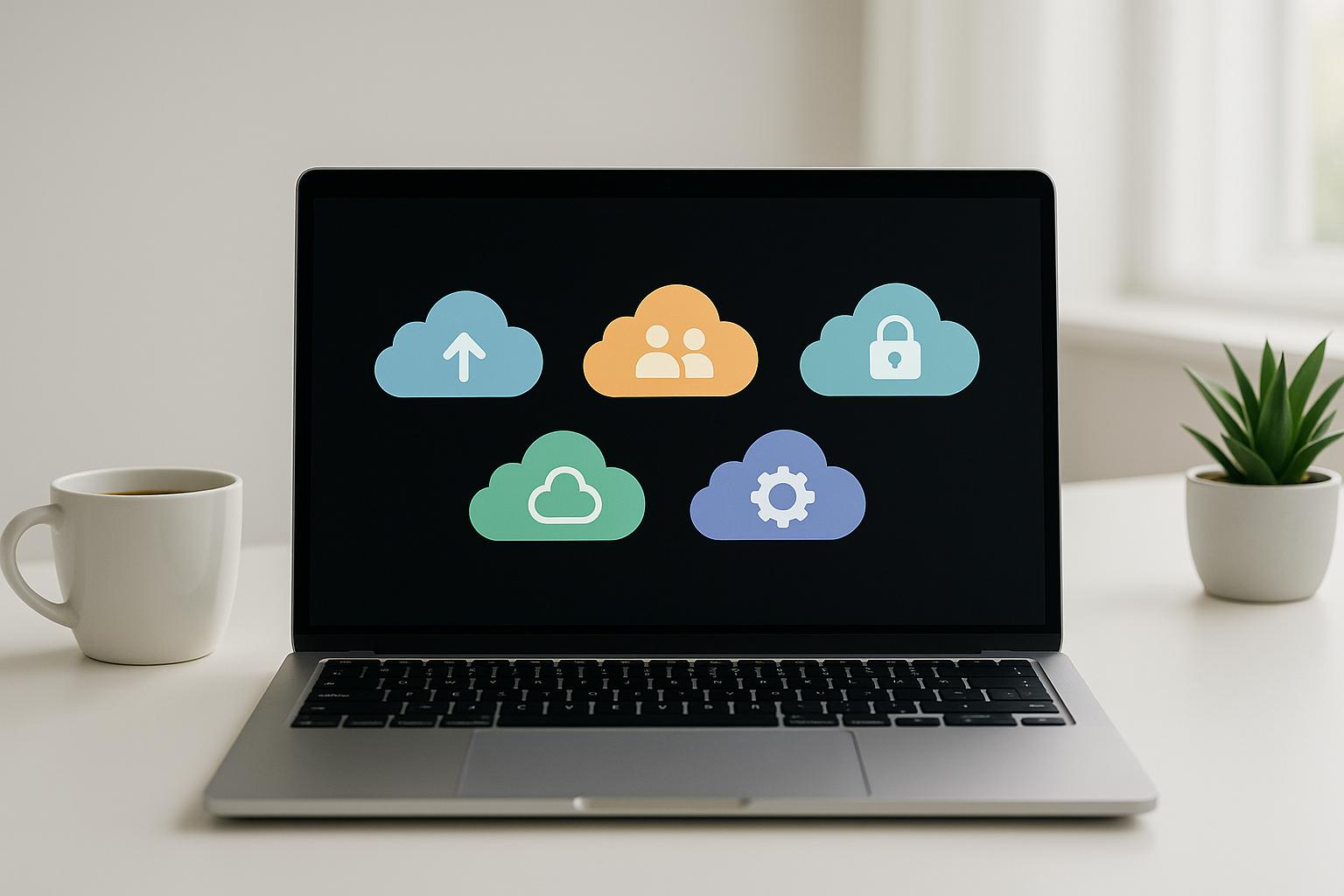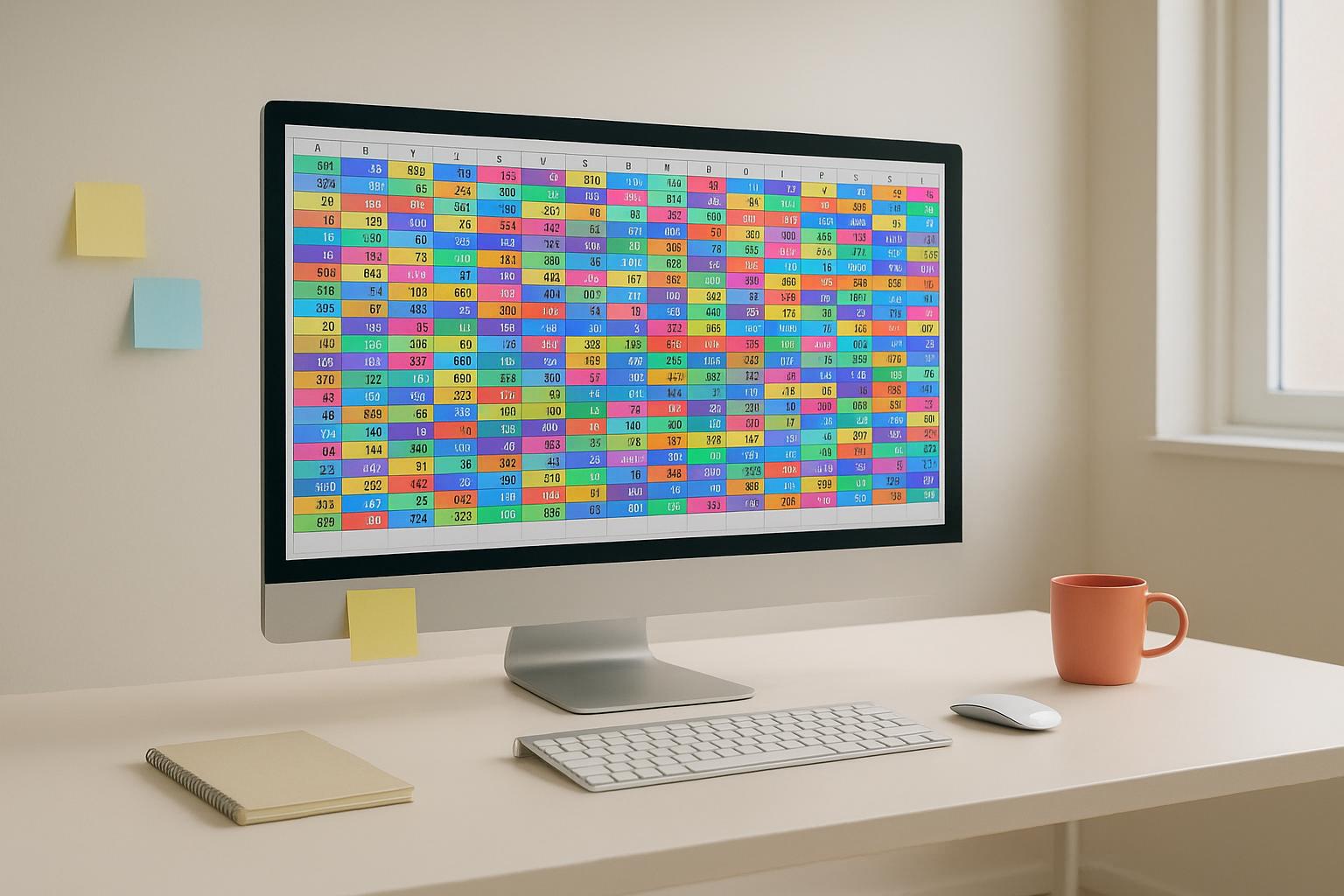Mobile Content Management (MCM) safeguards business data on mobile devices by focusing on securing content rather than the device itself. It creates encrypted "containers" for sensitive information, ensuring separation from personal data. This allows employees to use their devices for both work and personal purposes without security risks. Key features include:
- Access Controls: Role-based permissions, multi-factor authentication (MFA), and time/location-based restrictions.
- Encryption: Protects data both during transmission and storage using advanced standards like AES-256.
- Remote Wipe: Removes only business data in case of loss or theft, ideal for BYOD setups.
- Secure Connectivity: VPNs and certificate-based authentication protect data over public networks.
MCM also supports compliance with laws like HIPAA and GDPR, monitors user activity, and integrates with tools like Microsoft Endpoint Manager. Regular updates, employee training, and monitoring are essential to maintaining security. With MCM, businesses can reduce risks, secure mobile data, and meet regulatory standards.
Vaultize: Mobile Content Management (MCM)

Key Security Features of MCM
MCM incorporates a range of features designed to safeguard mobile data, addressing the specific challenges of managing sensitive information on mobile devices. These features work together to create a layered approach to security.
User Access Controls
MCM uses role-based permissions to assign access levels according to job responsibilities. For instance, managers might have full access, while representatives are limited to specific data. To further enhance security, multi-factor authentication (MFA) requires users to verify their identity through a combination of methods, such as passwords, smartphones, or biometric data. This ensures that even if a password is compromised, unauthorized access is still blocked.
Approval workflows add another layer of security by routing sensitive data requests through designated channels, creating clear audit trails. Additionally, time-based and geographic restrictions limit access to certain hours or locations, reducing risks outside of normal business operations. On top of these measures, MCM employs advanced encryption to secure data at all stages.
Data Encryption
Encryption is a cornerstone of MCM's security strategy, protecting data both in transit and at rest. End-to-end encryption ensures that data remains secure from the sender to the recipient, while at-rest encryption safeguards stored files using AES-256, one of the most advanced encryption standards available.
To manage encryption keys securely, MCM uses automated key management systems that handle key generation, distribution, and rotation, keeping keys stored separately from the encrypted data. For highly sensitive information, stronger encryption measures can be applied, balancing security needs with system performance. These encryption protocols are complemented by remote management tools for added protection.
Remote Wipe and Device Management
MCM's selective wipe capabilities allow administrators to remove only business-related data from a device, leaving personal information intact - an essential feature for BYOD (Bring Your Own Device) environments. Automatic wipe triggers can be set to activate under specific conditions, such as multiple failed login attempts or prolonged disconnection from the corporate network.
To ensure compliance, MCM continuously monitors devices for security standards, restricting access automatically if a device is detected as jailbroken or rooted. Administrators also have granular control over device functions, such as disabling cameras in secure areas, blocking copy-paste functions, or restricting access to personal cloud storage. These measures are further bolstered by secure network connectivity protocols.
Secure Network Connectivity
MCM ensures data remains protected during transmission by employing secure connectivity protocols. VPN integration creates encrypted tunnels between mobile devices and corporate networks, safeguarding data even when users connect via public Wi-Fi. This also masks device locations for additional privacy.
Certificate-based authentication replaces traditional passwords with digital certificates, providing a unique way to identify devices and users securely. Network access control evaluates the health of a device and user credentials before granting access, automatically restricting connections if any security issues are detected. Additionally, secure communication protocols with industry-standard encryption and traffic monitoring help identify unusual patterns that could signal potential threats.
How to Implement MCM in Your Business
To protect mobile data effectively, implementing Mobile Content Management (MCM) requires a well-structured approach. This process typically involves three key phases: assessing your needs, deploying the right solutions, and regularly updating your policies. By following these steps, you can align your mobile security strategy with both business goals and regulatory standards.
Conduct a Security Needs Assessment
Before diving into MCM solutions, it’s crucial to evaluate your current mobile security setup. This assessment is the backbone of your implementation strategy, helping you identify vulnerabilities that could lead to data breaches.
Start by auditing how mobile devices are used in your organization. Take note of how employees access and share data, including usage on both company-owned devices and personal devices (BYOD). This audit will give you a clear picture of your mobile data flow.
Next, compare your current practices against regulatory requirements like HIPAA or PCI-DSS. Pinpoint areas where your mobile security measures fall short of compliance.
Understanding how sensitive data is handled is another key step. Identify devices that access confidential information - such as customer records, financial data, or intellectual property - and map out how this data moves through your mobile systems. This will help you uncover weak points where vulnerabilities may exist.
You should also focus on specific security gaps. Are your encryption protocols up to par? Are access controls robust enough? Do you have strong policies in place to enforce security? For instance, a government contractor discovered critical gaps in encryption and access controls before implementing their MCM solution.
Lastly, assess whether your organization is technically and operationally ready for MCM. Check if your IT infrastructure can handle the new security measures and whether your team has the expertise to manage the solution effectively. Once you’ve gathered these insights, you’re ready to move to the next phase.
Deploy and Configure MCM Solutions
With a clear understanding of your needs, you can now choose an MCM platform that fits your business. Consider factors like compliance requirements, the size of your mobile device fleet, and how well the solution integrates with your existing systems.
Integration is often the trickiest part of deployment. Your MCM solution must work smoothly with your email servers, file storage systems, and business applications. Be prepared for potential downtime and communicate with your team ahead of time to minimize disruptions.
When configuring the system, focus on addressing the vulnerabilities you identified earlier. Set up encryption and access controls to protect data in transit and at rest. Use role-based access controls to ensure employees only access the data they need for their roles.
For BYOD environments, plan device enrollment carefully. Create procedures for onboarding personal devices while respecting privacy concerns. Incorporate compliance checks to monitor the health and security status of all devices.
Before rolling out the solution company-wide, run a testing phase. Select a pilot group from different departments to identify issues and gather feedback. This allows you to fine-tune policies and resolve technical challenges before full deployment. After deployment, ongoing monitoring and adjustments will help maintain security.
Monitor and Update Policies Regularly
MCM implementation isn’t a one-and-done process. Continuous monitoring and regular updates are essential to keep your mobile data secure in an ever-changing threat landscape.
Set up systems to track user activity, monitor device compliance, and flag suspicious behavior like failed login attempts or unauthorized data access. Early detection of anomalies can prevent potential breaches.
Schedule regular policy reviews - quarterly or semi-annually - to update permissions and encryption standards as needed. Stay informed about new threats by subscribing to security advisories from your MCM vendor and industry groups. Adjust your policies to address emerging risks.
Employee training is equally important. Regularly update training programs to reflect new security measures and ensure employees understand how these changes impact their daily work. This helps reinforce the importance of compliance and vigilance.
Finally, document all policy changes and maintain logs of security incidents. These records are invaluable for compliance audits and can reveal patterns that might indicate deeper security issues needing attention.
sbb-itb-d1a6c90
Managing Data Sharing and Access on Mobile Devices
Securing mobile environments goes beyond robust Mobile Content Management (MCM) features - it involves controlling how data is shared and accessed. This step is crucial in determining the success of your mobile security strategy. The goal? Create secure channels for sharing while ensuring only authorized access.
Enable Secure File Sharing
Traditional file-sharing methods, like email attachments or consumer-grade cloud platforms, can expose sensitive data to unnecessary risks. MCM solutions address these vulnerabilities by using encrypted containers to separate business data from personal content on mobile devices.
Here’s how you can improve file-sharing security:
- Role-based permissions: Limit access based on job responsibilities, ensuring employees only see the data they need.
- Version control: Prevent conflicts by tracking document changes when multiple team members collaborate. This eliminates the chaos of juggling multiple versions shared through unsecured apps or email.
- Time-limited access: Set expiration dates for document access or revoke permissions instantly when projects wrap up or employees leave. This avoids lingering access that could lead to security gaps.
- Watermarking and restrictions: Add digital watermarks to identify document sources and prevent unauthorized actions like screenshots or text copying.
After files are shared securely, continuous monitoring becomes essential to ensure they aren’t misused.
Monitor and Audit User Activities
Keeping an eye on how employees interact with mobile data is critical for preventing breaches. MCM platforms provide detailed activity logs that record every interaction with business content.
Key features to enhance monitoring include:
- Real-time alerts: Notify administrators of suspicious activity immediately, enabling swift responses.
- Geolocation tracking: Add context by flagging unusual access attempts from unexpected locations.
- Data loss prevention (DLP): Automatically scan outgoing communications for sensitive information, such as Social Security numbers or credit card details, and block unauthorized transmissions.
- Automated compliance reporting: Generate audit trails that meet regulatory requirements for industries like healthcare, finance, and government contracting. These reports document who accessed which files and when, ensuring transparency for compliance officers.
Best Practices for Secure Data Sharing
The way businesses approach data sharing can make or break their defenses against costly breaches. Here are some best practices to follow:
- Use container-based sharing to keep business data encrypted and separate from personal apps or content on employee devices.
- Require multi-factor authentication (MFA) and encrypt data transmissions through secure tunnels to add extra layers of protection.
- Conduct regular access reviews to revoke permissions for employees who’ve changed roles or left the company. Automating this process with HR system integration minimizes human error.
- Combine education with policy enforcement. Employees need clear guidelines on approved sharing methods and regular training to stay alert to potential security threats.
- Implement backup and recovery protocols. Automatically back up business data to secure cloud storage and maintain the ability to remotely wipe compromised devices without affecting the backups.
Maintaining Compliance and Security with MCM
Expanding on its role in data control, Mobile Content Management (MCM) also strengthens compliance with regulations and supports seamless integration with business systems. In a world where mobile devices dominate business operations, staying compliant with regulations and ensuring robust security is non-negotiable. MCM solutions make this process easier by automating sensitivity labeling and working effortlessly with essential business tools.
Regulatory Compliance Support
MCM solutions rely on classification labels to automatically identify and categorize sensitive data, ensuring the correct protections are applied across all mobile devices. This system minimizes human error and ensures compliance with regulations like HIPAA for healthcare providers and GDPR for organizations handling European data. By automating compliance tasks, MCM solutions reduce mistakes while guaranteeing that every device adheres to industry standards.
Integrating MCM with Business Tools
The effectiveness of MCM solutions is amplified when they integrate smoothly with existing systems. For example, Microsoft Endpoint Manager combines Microsoft Configuration Manager and Intune to centralize device management and enhance security. Additionally, integration with Security Information and Event Management (SIEM) tools provides detailed reporting, helping businesses meet complex regulatory requirements seamlessly. Platforms like BizBot even offer directories of tools designed to complement MCM systems.
Integration with Data Loss Prevention (DLP) policies ensures consistent protection across platforms. When MCM solutions align with classification labels and DLP policies, they maintain uniform security measures across devices, locations, and applications.
Conclusion
Mobile Content Management (MCM) plays a vital role in protecting businesses that rely heavily on mobile devices. With data breaches costing U.S. businesses an average of $9.48 million in 2023, having a strong MCM strategy in place is more important than ever.
MCM provides multiple layers of defense through features like user access controls, data encryption, remote wipe capabilities, and secure network connectivity. Together, these tools help safeguard sensitive data across various environments, reducing the risk of unauthorized access and data breaches.
However, implementing MCM is just the first step. Its success hinges on ongoing vigilance. Cyberattacks are constantly evolving, making continuous monitoring and regular updates a necessity. Staying proactive ensures threats are identified early, minimizing potential damage.
Another key advantage of modern MCM solutions is their ability to integrate seamlessly with existing tools. This integration not only reduces breach costs by over $1.7 million but also speeds up threat detection by 70%. For even greater efficiency, tools like BizBot can help streamline integration and ensure compliance, saving time and effort for administrators.
To maximize the benefits of MCM, businesses must commit to security best practices. Regular assessments, policy updates, and employee training are essential to maintaining a secure and compliant environment. These efforts build on the foundational elements of encryption, access controls, and remote management, ensuring long-term protection for sensitive data.
FAQs
What makes Mobile Content Management (MCM) different from traditional Mobile Device Management (MDM) when it comes to protecting business data?
Mobile Content Management (MCM) zeroes in on protecting and managing business data within mobile apps. It allows for precise control over data access, encryption, and in-app security settings, ensuring that sensitive information stays safe from unauthorized access or potential breaches.
On the other hand, Mobile Device Management (MDM) takes a broader approach, focusing on securing the entire device. It includes features like remote wiping, device tracking, and enforcing security protocols. While MDM secures devices as a whole, MCM sharpens the focus on data-specific protection, making it especially useful for keeping critical business information within apps secure.
What steps are essential for implementing Mobile Content Management (MCM) in a business, and how can companies meet compliance requirements like HIPAA and GDPR?
Successfully rolling out Mobile Content Management (MCM) starts with a clear understanding of your organization's data security needs. Begin by assessing potential risks tied to mobile device usage and identifying any weak points that could compromise your data.
Once you've mapped out your needs, select an MCM solution that fits your business objectives. Look for essential features like encryption, secure file sharing, and remote access control to ensure your data stays protected.
For businesses subject to regulations like HIPAA or GDPR, it's critical to configure MCM tools to enforce strict data protection measures. This includes implementing user authentication, using encryption protocols, and scheduling regular audits. Beyond the tools themselves, training your team on secure mobile practices and keeping up with regulatory updates are key steps to safeguarding sensitive information and staying compliant.
How does MCM protect sensitive business data on employee devices in BYOD (Bring Your Own Device) setups?
MCM tackles data security challenges in BYOD (Bring Your Own Device) setups through Mobile Application Management (MAM) and Mobile Device Management (MDM). Here's how they differ:
- MAM secures business data at the app level, ensuring that only work-related applications are managed while leaving personal apps and data untouched.
- MDM, on the other hand, enforces broader security measures across entire devices. These include encryption, password policies, and even remote wipe features to protect both corporate and personal devices.
This dual-layered approach strikes a balance between safeguarding sensitive business information and respecting employees' privacy. By keeping personal and work data separate, MCM supports a secure yet user-friendly BYOD environment, offering reassurance to both employers and employees.


